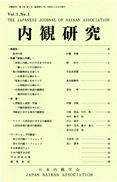Volume 14, Issue 1
Displaying 1-11 of 11 articles from this issue
- |<
- <
- 1
- >
- >|
OPENING REMARKS (EDITORIAL)
-
2008 Volume 14 Issue 1 Pages 1
Published: April 15, 2008
Released on J-STAGE: September 30, 2022
Download PDF (838K)
SPECIAL FOCUS
-
2008 Volume 14 Issue 1 Pages 3
Published: April 15, 2008
Released on J-STAGE: September 30, 2022
Download PDF (839K) -
2008 Volume 14 Issue 1 Pages 5-9
Published: April 15, 2008
Released on J-STAGE: September 30, 2022
Download PDF (1163K) -
2008 Volume 14 Issue 1 Pages 11-16
Published: April 15, 2008
Released on J-STAGE: September 30, 2022
Download PDF (977K) -
2008 Volume 14 Issue 1 Pages 17-24
Published: April 15, 2008
Released on J-STAGE: September 30, 2022
Download PDF (910K) -
2008 Volume 14 Issue 1 Pages 25-32
Published: April 15, 2008
Released on J-STAGE: September 30, 2022
Download PDF (913K)
ORIGINAL ARTICLES
-
2008 Volume 14 Issue 1 Pages 33-44
Published: April 15, 2008
Released on J-STAGE: September 30, 2022
Download PDF (933K) -
2008 Volume 14 Issue 1 Pages 45-57
Published: April 15, 2008
Released on J-STAGE: September 30, 2022
Download PDF (1588K)
CASE REPORTS
-
2008 Volume 14 Issue 1 Pages 59-66
Published: April 15, 2008
Released on J-STAGE: September 30, 2022
Download PDF (1253K) -
2008 Volume 14 Issue 1 Pages 67-72
Published: April 15, 2008
Released on J-STAGE: September 30, 2022
Download PDF (903K)
POINT OF CONTENTION
-
2008 Volume 14 Issue 1 Pages 73-78
Published: April 15, 2008
Released on J-STAGE: September 30, 2022
Download PDF (904K)
- |<
- <
- 1
- >
- >|
